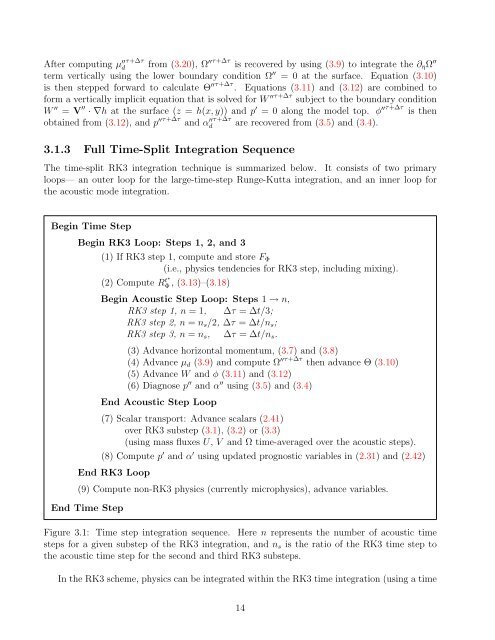Advanced Research WRF (ARW) Technical Note - MMM - University ...
Advanced Research WRF (ARW) Technical Note - MMM - University ...
Advanced Research WRF (ARW) Technical Note - MMM - University ...
You also want an ePaper? Increase the reach of your titles
YUMPU automatically turns print PDFs into web optimized ePapers that Google loves.
After computing µ ′′ τ+∆τ ′′τ+∆τ<br />
d from (3.20), Ω is recovered by using (3.9) to integrate the ∂ηΩ ′′<br />
term vertically using the lower boundary condition Ω ′′ = 0 at the surface. Equation (3.10)<br />
is then stepped forward to calculate Θ ′′τ+∆τ<br />
. Equations (3.11) and (3.12) are combined to<br />
form a vertically implicit equation that is solved for W ′′τ+∆τ<br />
subject to the boundary condition<br />
W ′′ = V ′′ · ∇h at the surface (z = h(x, y)) and p ′ = 0 along the model top. φ ′′τ+∆τ is then<br />
obtained from (3.12), and p ′′τ+∆τ and α ′′<br />
d<br />
3.1.3 Full Time-Split Integration Sequence<br />
τ+∆τ are recovered from (3.5) and (3.4).<br />
The time-split RK3 integration technique is summarized below. It consists of two primary<br />
loops— an outer loop for the large-time-step Runge-Kutta integration, and an inner loop for<br />
the acoustic mode integration.<br />
Begin Time Step<br />
Begin RK3 Loop: Steps 1, 2, and 3<br />
(1) If RK3 step 1, compute and store FΦ<br />
(i.e., physics tendencies for RK3 step, including mixing).<br />
(2) Compute Rt∗ Φ , (3.13)–(3.18)<br />
Begin Acoustic Step Loop: Steps 1 → n,<br />
RK3 step 1, n = 1, ∆τ = ∆t/3;<br />
RK3 step 2, n = ns/2, ∆τ = ∆t/ns;<br />
RK3 step 3, n = ns, ∆τ = ∆t/ns.<br />
(3) Advance horizontal momentum, (3.7) and (3.8)<br />
(4) Advance µd (3.9) and compute Ω ′′τ+∆τ then advance Θ (3.10)<br />
(5) Advance W and φ (3.11) and (3.12)<br />
(6) Diagnose p ′′ and α ′′ using (3.5) and (3.4)<br />
End Acoustic Step Loop<br />
(7) Scalar transport: Advance scalars (2.41)<br />
over RK3 substep (3.1), (3.2) or (3.3)<br />
(using mass fluxes U, V and Ω time-averaged over the acoustic steps).<br />
(8) Compute p ′ and α ′ using updated prognostic variables in (2.31) and (2.42)<br />
End RK3 Loop<br />
(9) Compute non-RK3 physics (currently microphysics), advance variables.<br />
End Time Step<br />
Figure 3.1: Time step integration sequence. Here n represents the number of acoustic time<br />
steps for a given substep of the RK3 integration, and ns is the ratio of the RK3 time step to<br />
the acoustic time step for the second and third RK3 substeps.<br />
In the RK3 scheme, physics can be integrated within the RK3 time integration (using a time<br />
14
















